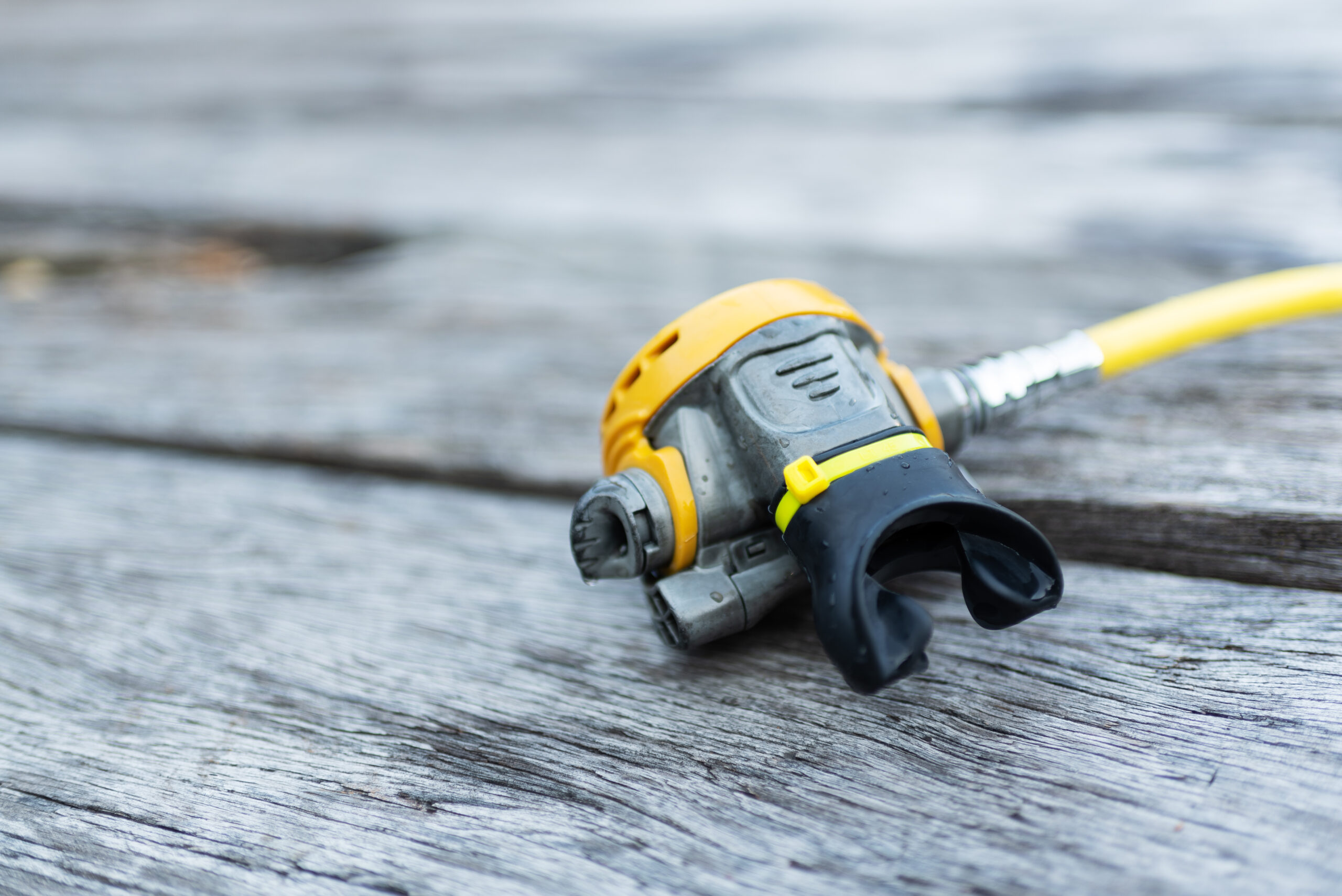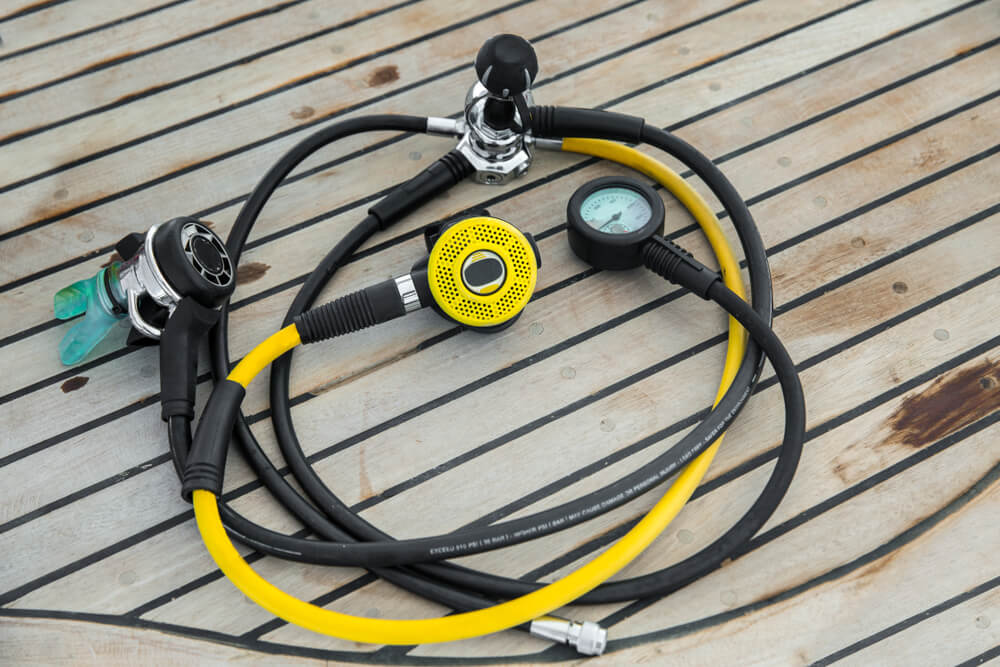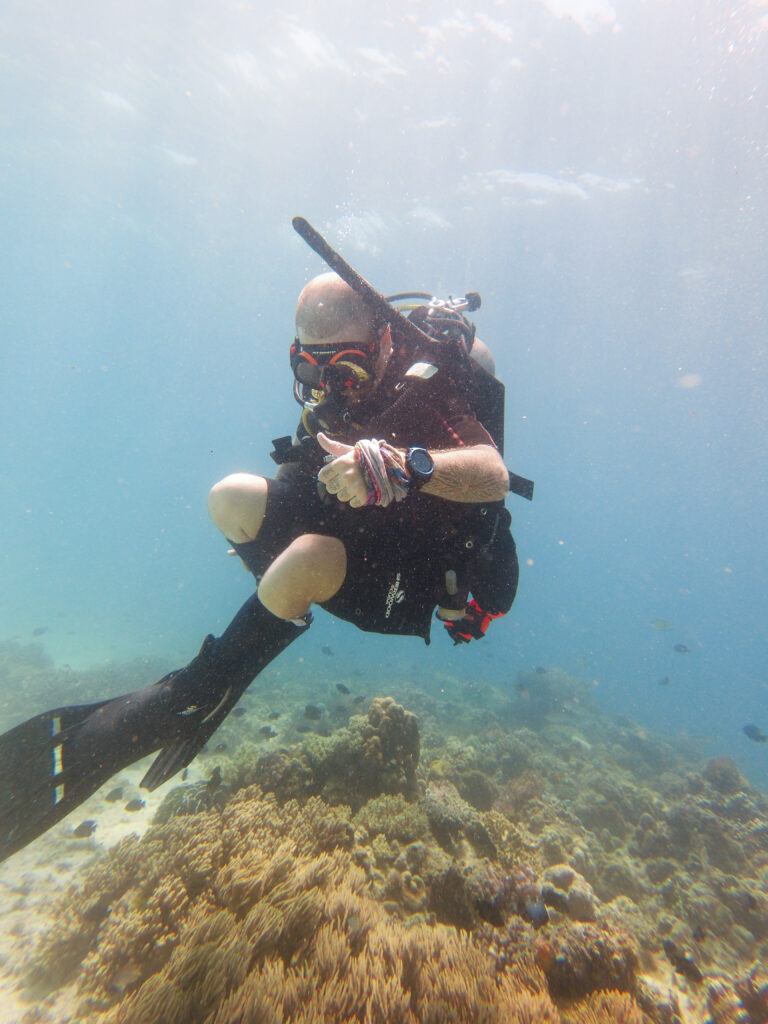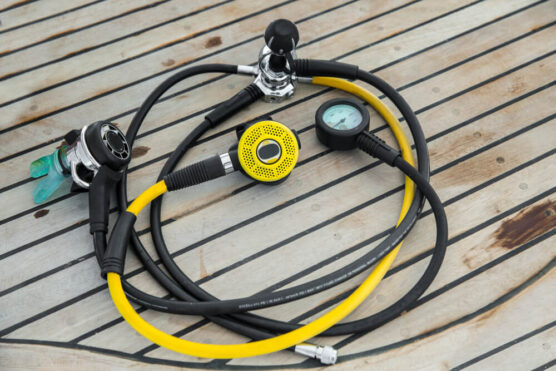
A great scuba regulator will have a mouthpiece that feels comfortable in your mouth, a mechanism that breathes easily and be constructed from materials that are durable and tough.
Scuba regulators vary a lot so it’s important to pick the right one. There’s no point buying something low quality that needs replacing soon after; however you also don’t want to overspend!
Budget scuba regulators get the job done but tend to be lower in quality; being made from cheaper materials and with less sophisticated internal operating mechanisms.
More expensive ones have greater durability and comfort and are also easier to breathe. Plus they can include special features like airflow restrictors and sometimes even swivel torrents.
We’ve reviewed the 10 best scuba diving regulators of 2025. We’ve created these reviews by writing about our own scuba regulators and interviewing other divers about theirs!
Regulator cost, durability, compactness, comfort and ease of breathing have all been accounted for.
Dive down to the Quick Look for a brief synopsis of each one or descend deeper to our Detailed Reviews.
Also, a scuba regulator can follow several designs: balanced or unbalanced, diaphragm or piston and so forth.
Whoaaa! Some of this nerd-babble jargon not making any sense!? Never fear. We’ve covered all that in the info section further down.
Ok, time to dive in and take a closer look!
QUICK LOOK:
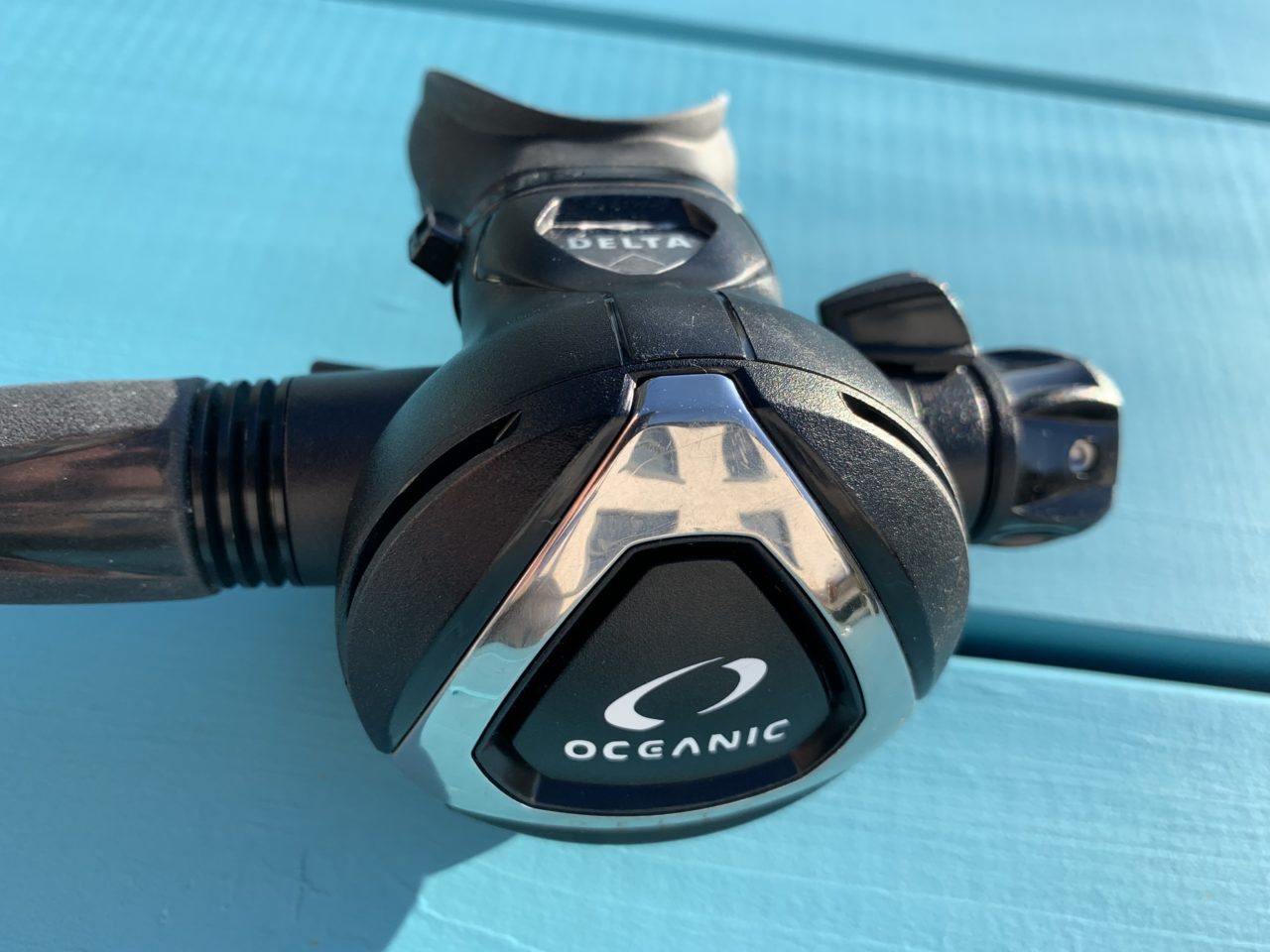
1) OUR TOP PICK: Oceanic Delta 5
Price: > $$
Air Delivery = Awesome
Airflow Adjustment
Dual-Material Mouthpiece
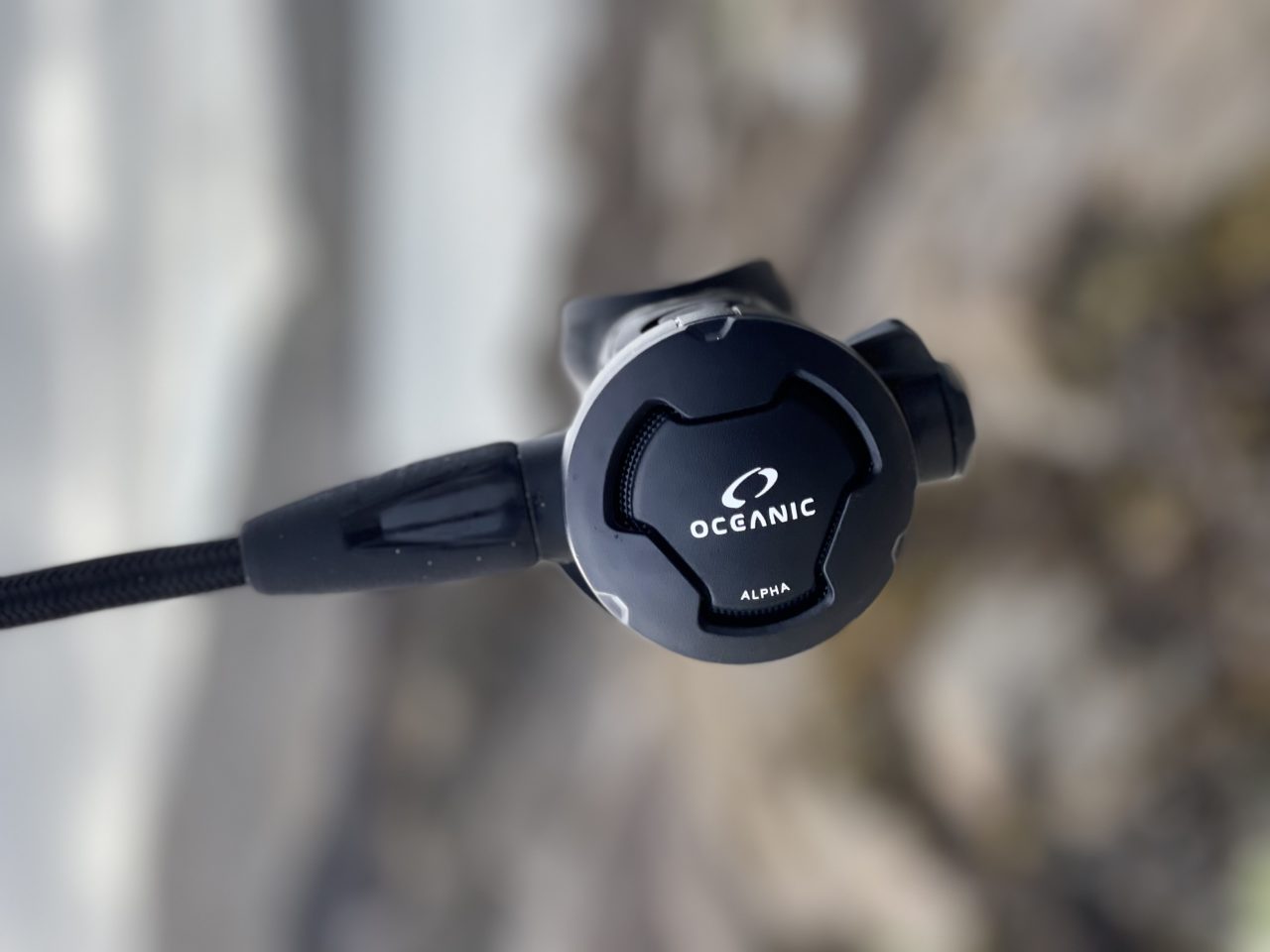
2) Best Backup Scuba Regulator: Oceanic Alpha 10
Price: > $$
Good Air Delivery
Airflow Adjustment
Orthodontic Mouthpiece
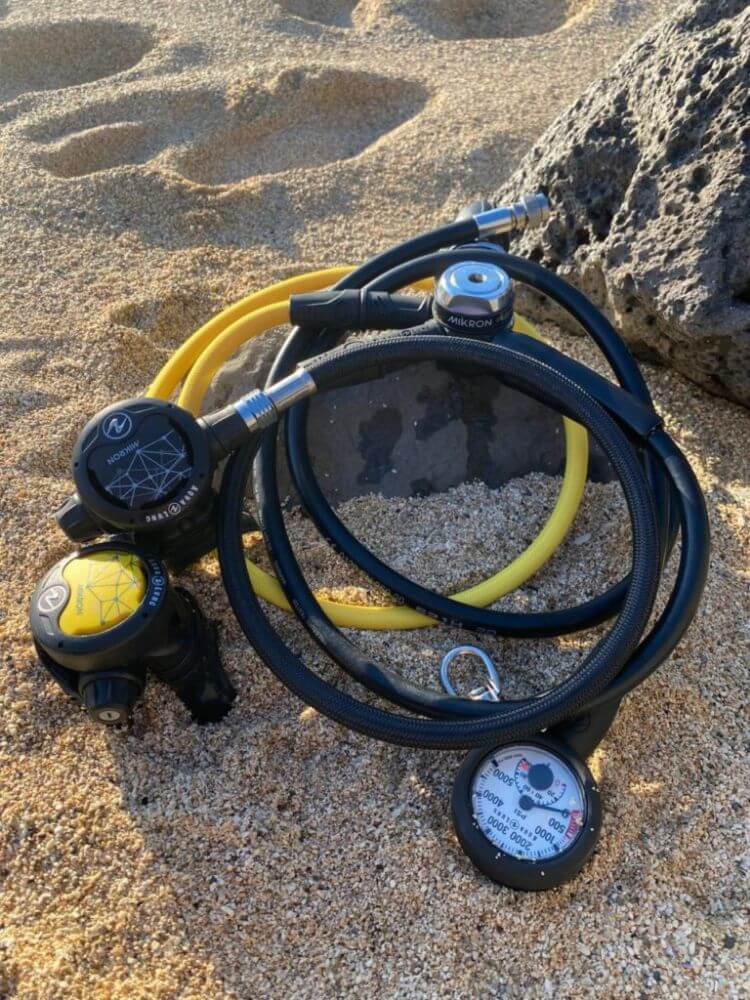
3) Best Travel Reg (+ Small Mouthpiece): Aqualung Mikron
Price: > $$
Lightest Mid-Price Reg
2 Sizes of Mouthpiece: Regular + Small
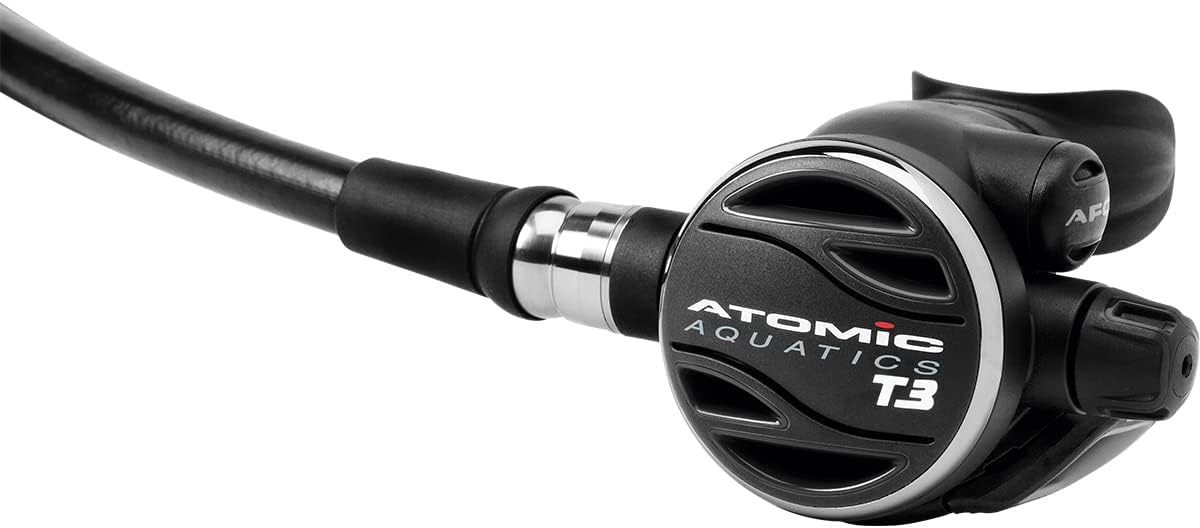
4) Best High-End Scuba Regulator: Atomic T3
Price: > $$$
Air Delivery = Superb
Airflow Adjustment
Titanium = Super Durable
Swivel Torrent + Ball Joint
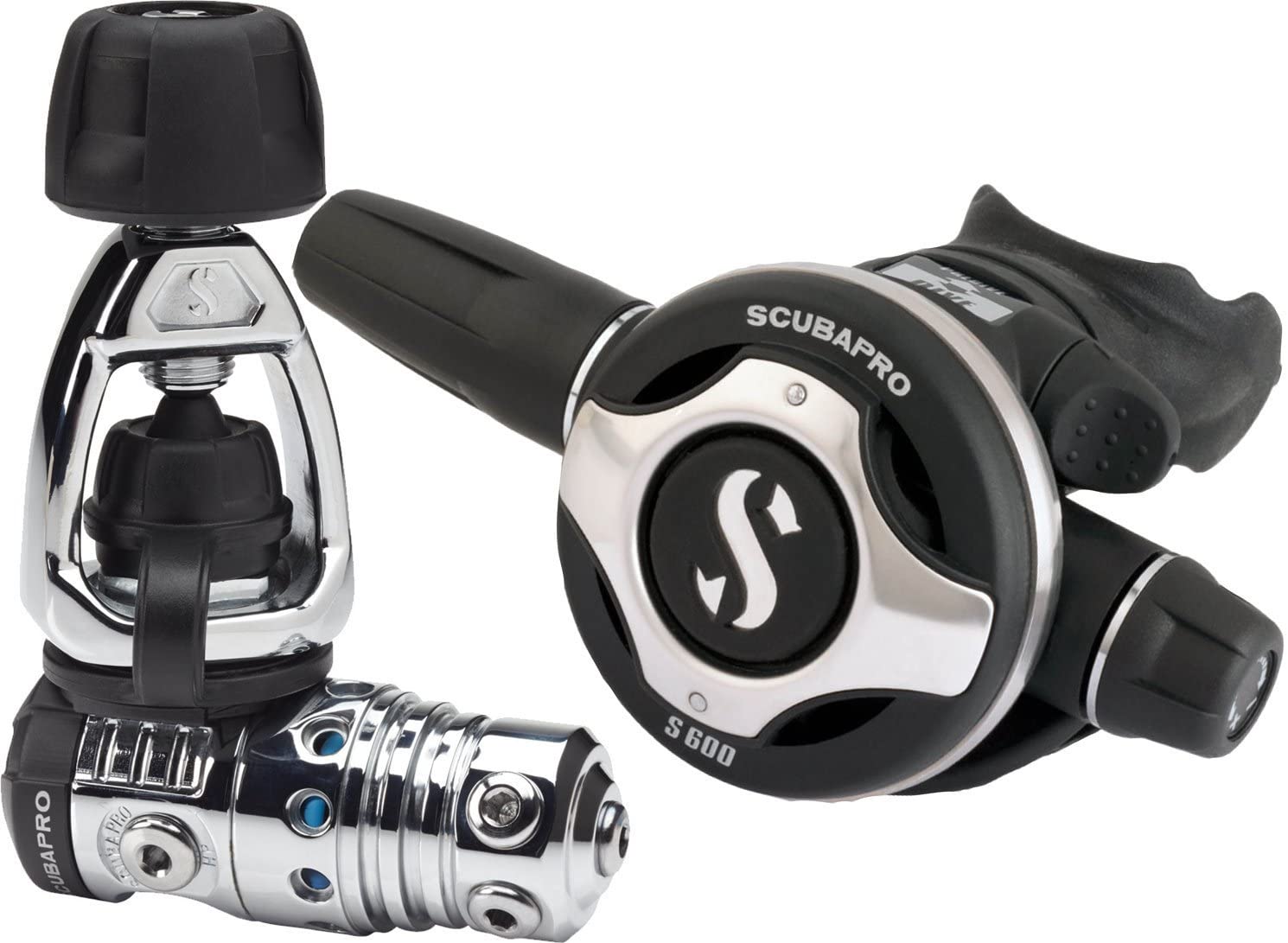
5) Runner-Up High End Regulator: ScubaPro MK25 A700
Price: > $$$
Great Air Delivery
Airflow Adjustment
Swivel Torrent
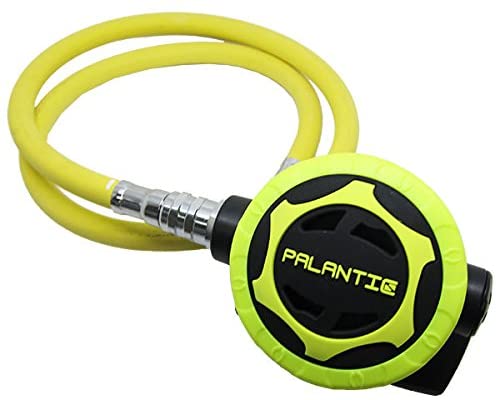
6) Cheapest Scuba Regulator: Palantic AS103
Price: > $
Includes 2 Second Stages
Silicone Mouthpiece
Durable
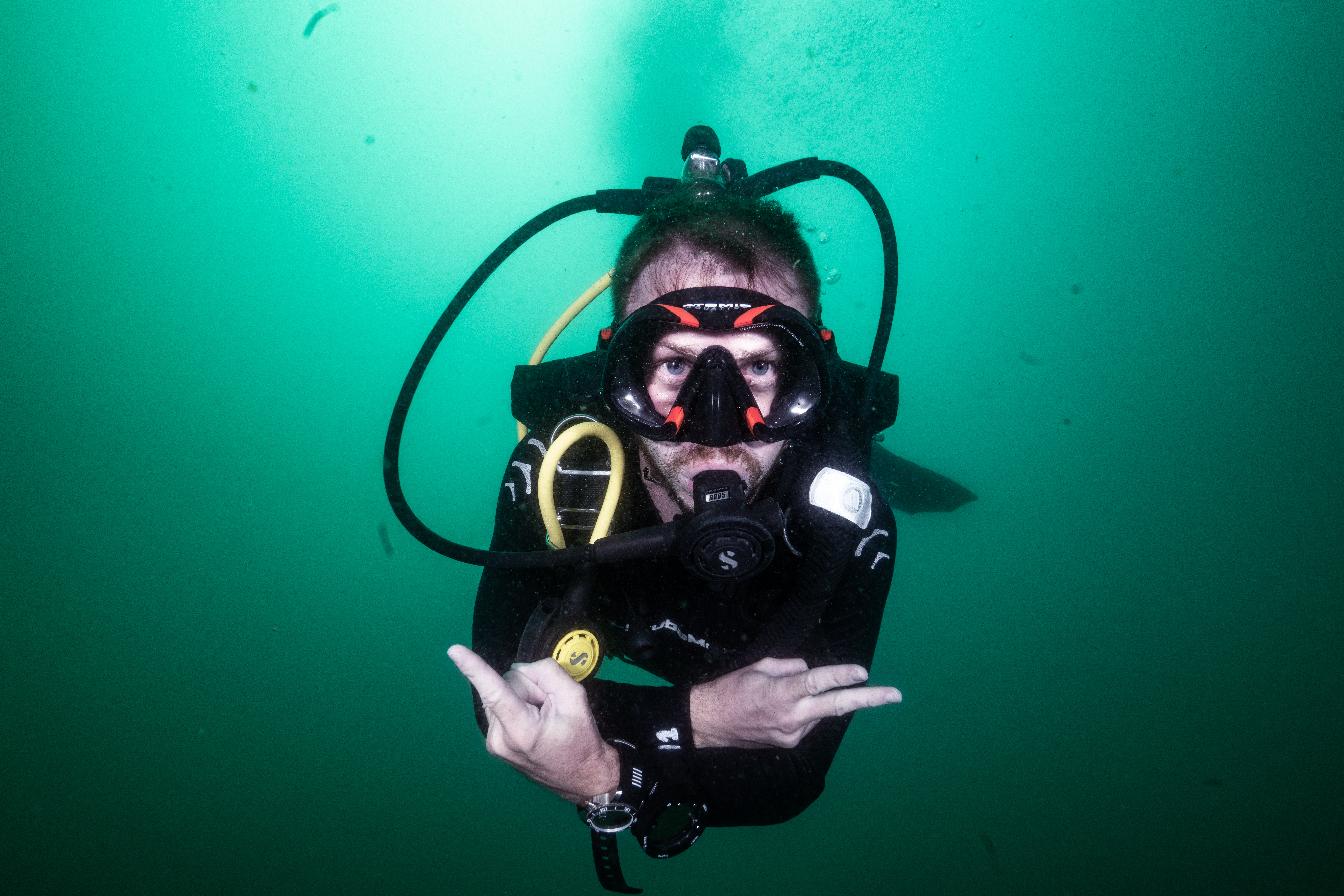
7) Best Scuba Regulator for Beginners: ScubaPro R095
Price: > $
Venturi-Initiated Vacuum Assist
Pre-set to Optimum Inhalation
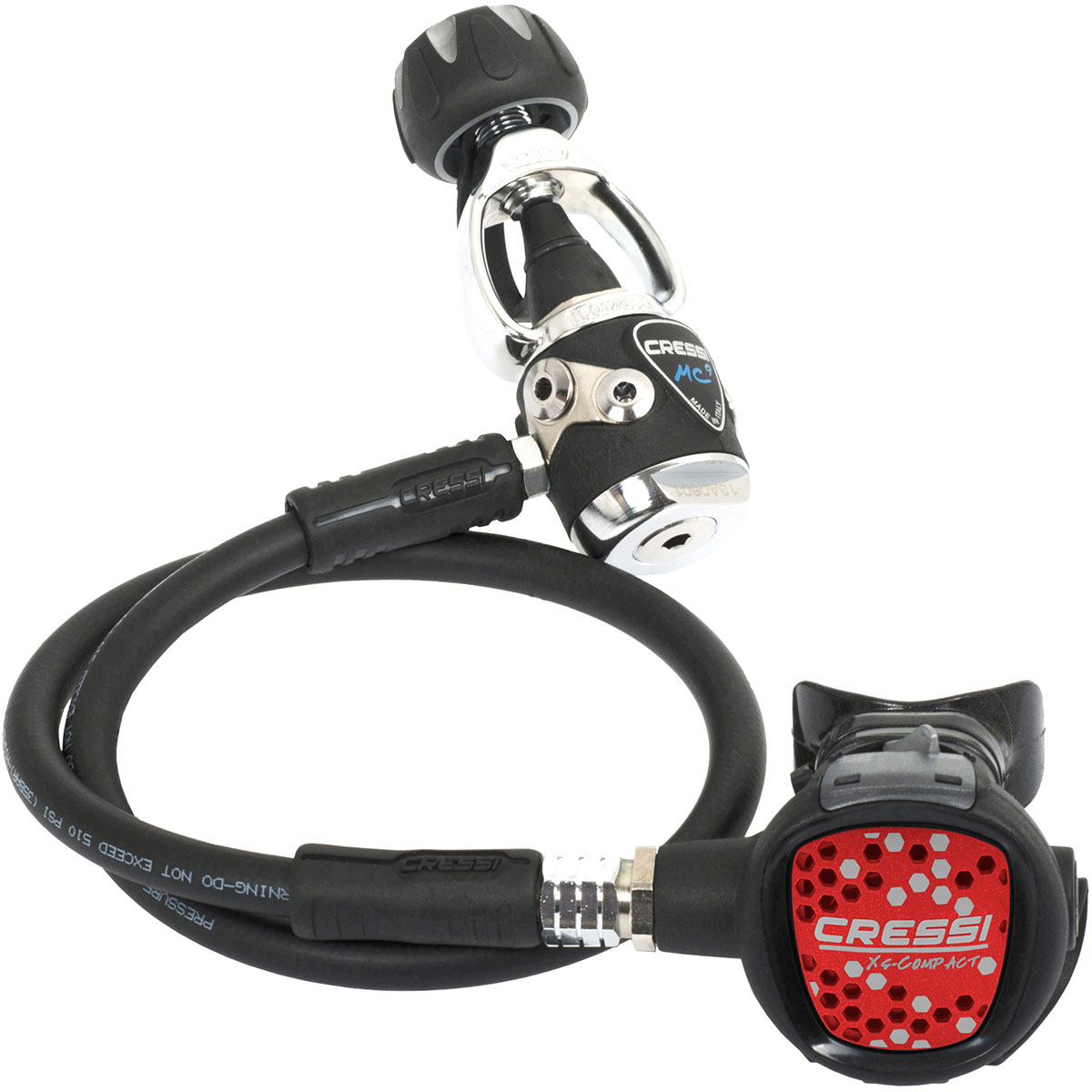
8) Coloured Purge Button: Cressi Compact MC9
Price: > $
Black, Red or Blue Purge Button
Anti-Scratch Surface
T-Shaped Mechanism
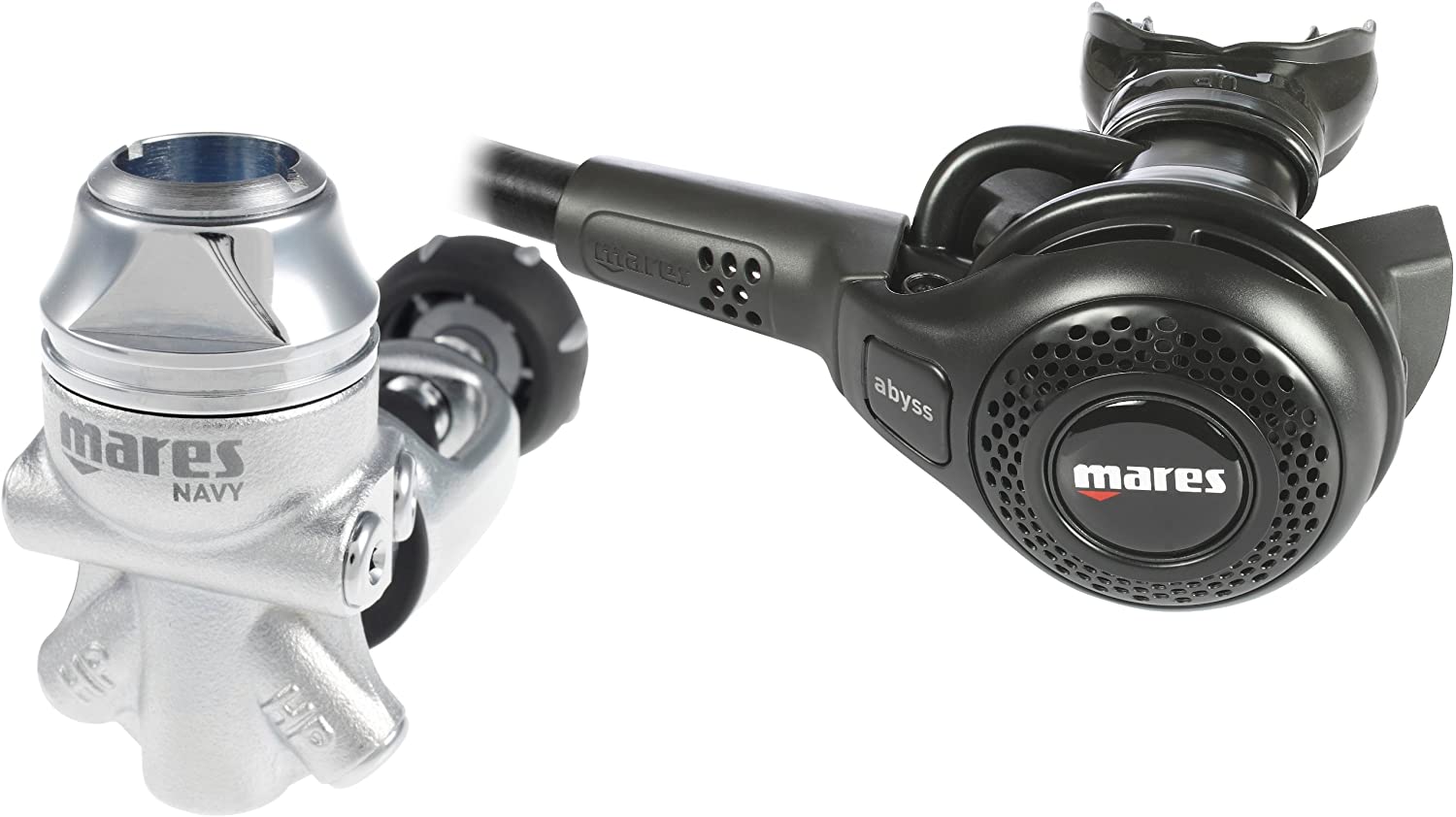
9) Military Regulator: Mares Abyss 22
Price: > $$$
All Metal – Super Durable
Downstream Demand System
Vortex Assisted Design
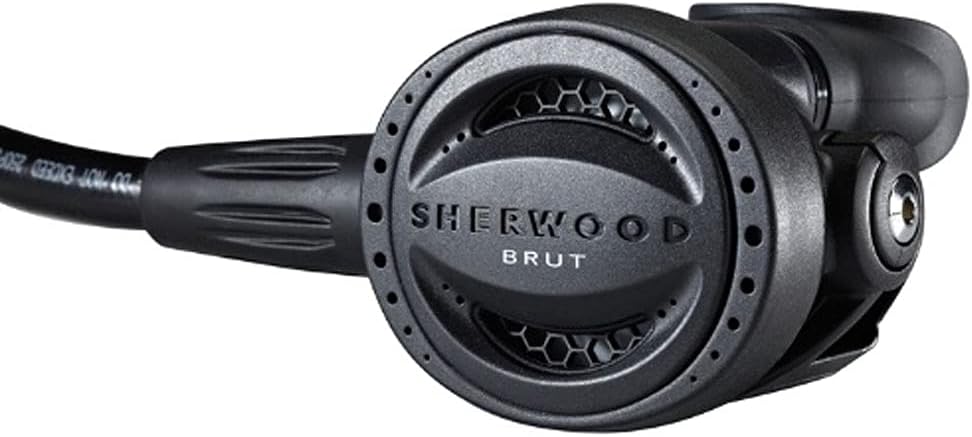
10) Most Durable Budget Regulator: Sherwood Scuba Brut Pro
Price: > $$
Marine Grade Brass
Mouthpiece made from 2 Types of Silicone
REVIEWS: Best Dive Regulators:
- Our TOP PICK: Oceanic Delta 5
- Best Back-Up Scuba Regulator: Oceanic Alpha 10
- Best Travel Regulator (+ Small Mouthpiece Option): Aqualung Mikron
- Best High-End Scuba Regulator: Atomic T3
- Runner-Up High-End Regulator: ScubaPro MK25
- Cheapest Scuba Regulator: Palantic AS103
- Best Scuba Regulator for Beginners: ScubaPro R095
- Coloured Purge Button Options: Cressi Compact MC9
- Regulator of Choice for Military: Mares Abyss 22
- Most Durable Budget Regulator: Sherwood Scuba Brut Pro
1) TOP PICK: Oceanic Delta 5
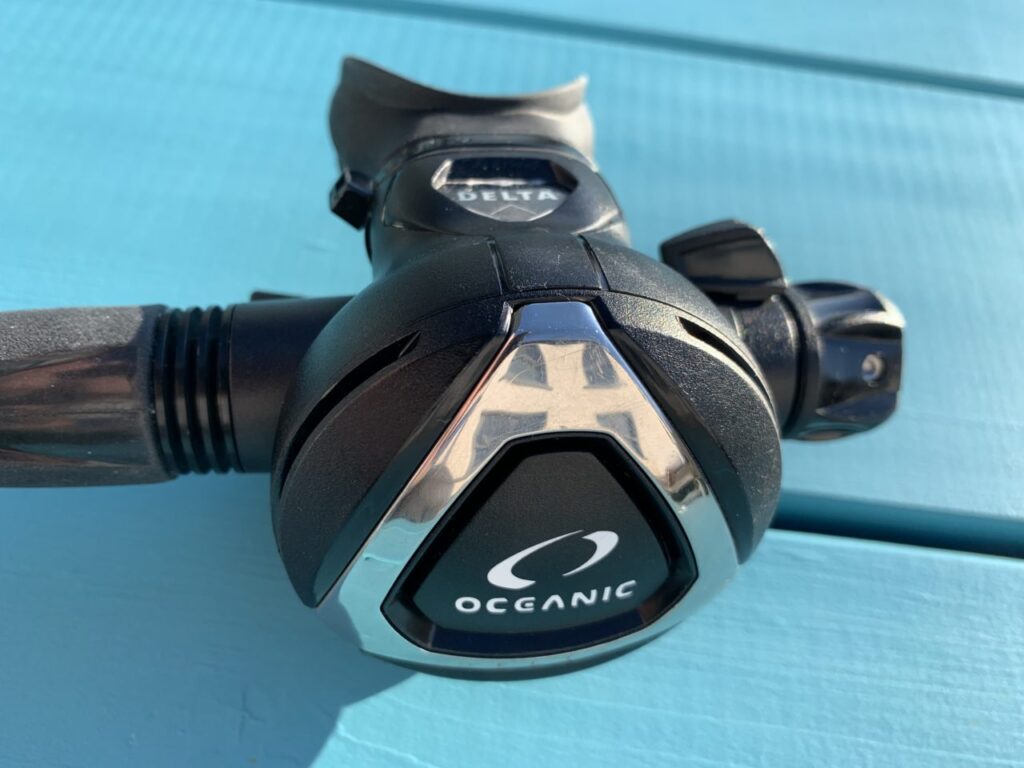
- Price:> $$
- Metal Pneumatically-Balanced Valve
- Airflow Adjustment Dial
- Dual-Material Orthodontic Mouthpiece
- Heat Exchanger (for cold water)
- Environmentally Sealed First Stage eDX
“I love my Oceanic Delta 5 scuba regulator! The first stage is super durable with an all-metal pneumatic valve and from an aesthetic point of view it really stands out thanks to the shiny metal triangle bordering the purge button.
Because the orthodontic mouthpiece is made from two materials, I’ve found it to be noticeably more comfortable compared to that of other scuba regulators meaning I never get a stiff jaw – even when I’m diving a lot!
The dynamic airflow control dial on the side lets you adjust how easily air is delivered which is extremely handy for delivering more air if you’re out of breath or reducing airflow if you want to use your air more conservatively.
Regardless of what the airflow dial is set to, this regulator breathes insanely smoothly; I’ve found air delivery noticeably better compared to other regs – plus it performs just as well in cold water as it does in tropical water.
For me the real cherry on top about the Oceanic Delta 5 regulator is that even though it performs, looks and feels fantastic it’s actually only mid-priced and subsequently offers awesome value for money”!
Alex: Grand Admiral of the Diving Squad
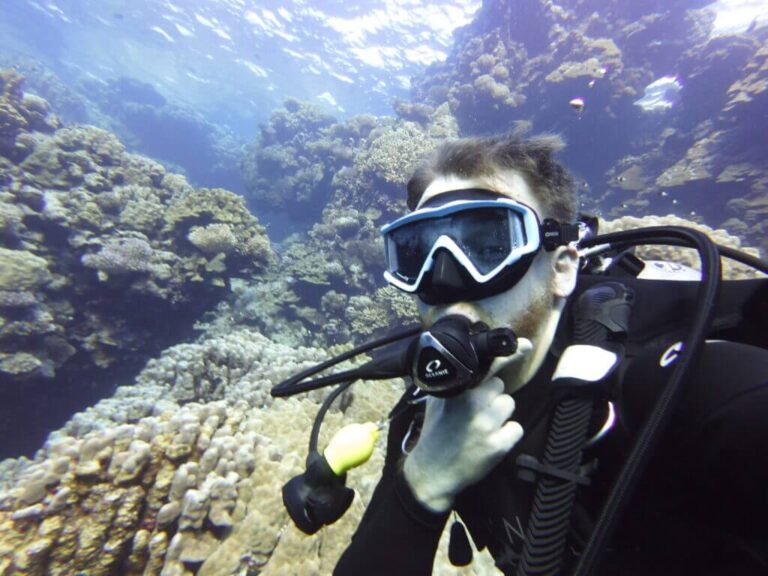
PROS:
- Excellent Value for Money
- Comfortable Mouthpiece
- Can Adjust Airflow
- Distinctive and Stylish First Stage
- Super Durable
- Works in Tropical and Cold Water
CONS:
- Still not as sophisticated as high-end scuba regulators
2) Best Backup Scuba Regulator: Oceanic Alpha 10
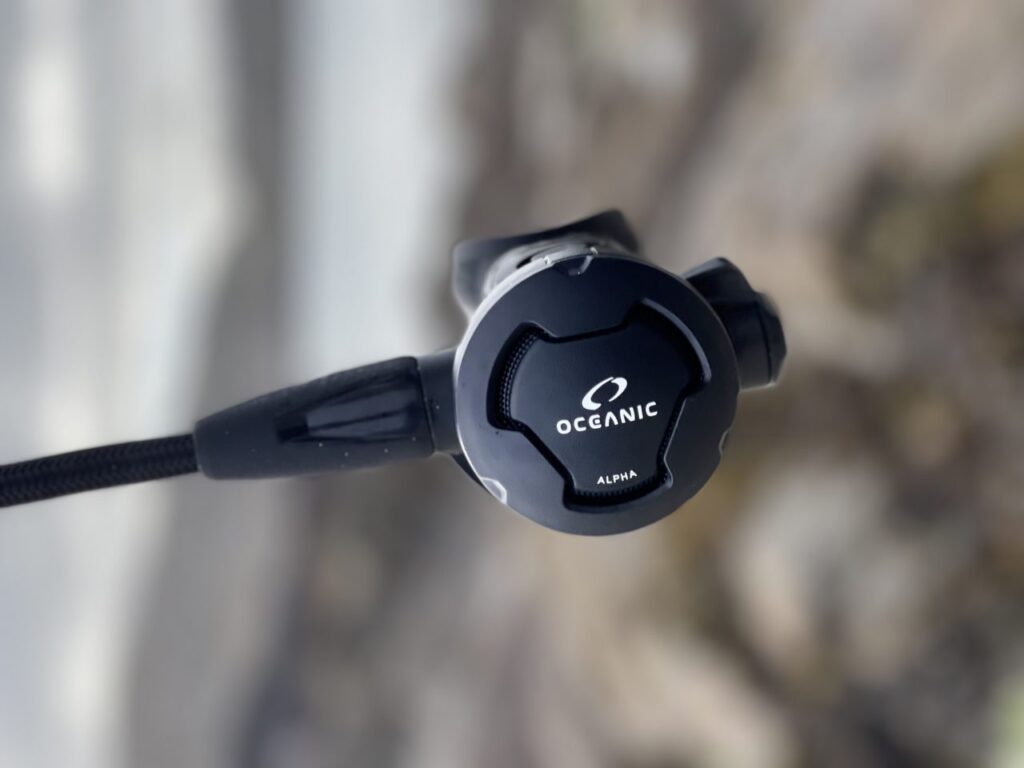
- Price:> $$
- Pneumatically Balanced Valve
- Airflow Adjustment (basic)
- Orthodontic Mouthpiece (single material)
- Triple Chrome Marine Brass
- Environmentally Sealed First Stage eDX
“Compact, reliable and affordable, my Oceanic Alpha 10 is also surprisingly durable thanks to being constructed from triple chrome marine brass with environmental protection.
It’s only slightly more expensive than low-budget scuba regulators yet is noticeably superior by having a basic airflow adjustment valve which lets you control air delivery rate. This is a seriously useful feature for a backup reg to have because if you’re using it to share air with a dive buddy, you may want to reduce airflow in order to make your remaining air last longer.
Weighing just 2.5 pounds (<1 kilogram), the Oceanic Alpha 10 is an awesome travel reg: lightness and compactness are definitely traits you want to look for in a backup second stage as your main one may already be more heavy and bulky.
I love using the Oceanic Alpha 10 as an alternate regulator because it really didn’t cost much to buy and add to my scuba octopus setup yet its still much lot better than the kind of super cheap reg you usually see divers taking as a backup second stage”.
Alex: Grand Admiral of the Diving Squad
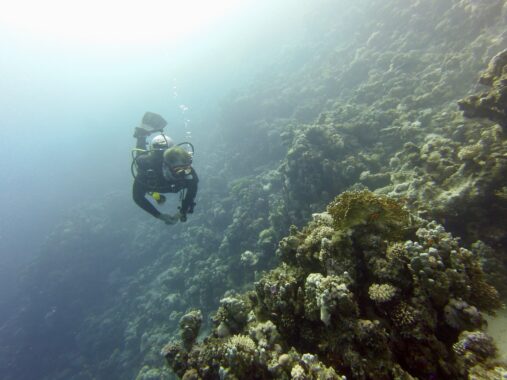
PROS:
- Cheap
- Durable
- Comfortable mouthpiece
- Easy breathing
- Airflow adjustment – rarely seen in cheap regulators!
CONS:
- Mouthpiece only made of one material (more expensive regulators feature dual-material mouthpieces).
- Airflow control dial is basic and a bit stiff (but virtually no other cheap scuba regulators have any airflow control at all).
3) Best Travel Regulator (+ Small Mouthpiece Option): Aqualung Mikron

- Price:> $$
- Lightest Regulator on the market (Weighs 1.7lb)
- Balanced Diaphragm First Stage
- Pneumatically Balanced Second Stage
- Comfo-bite Mouthpiece in 2 Sizes (Regular & Small)
“My experience using the Aqualung Mikron has been great – I originally chose this regulator because of how light it is with a total weight of just under 1.7lb! The second stage is also extremely compact which makes it easy to pack and gives it a unique and streamlined appearance. These features combine to make a regulator that is perfect for travel.
Besides this, it’s also a really nice regulator to use – the comfo-bite mouthpiece feels super soft and is very comfortable – I never get a stiff jaw from using this reg! It breathes very easily and you can also change the air intake via the air adjustment dial which is a super useful feature to have”!
Gabby Abouhassan: Diving Squad Contributor
There’s only one other scuba regulator as light as the Aqualung Mikron: the Atomic T3 and it’s much, much more expensive. So if you’re looking for a great travel regulator that won’t break the bank, the Aqualung Mirkon is your best bet.
Despite being lightweight and compact, don’t befooled: it’s also highly durable due to being equipped with the Aqualung patented auto-closure device (ACD) to prevent corrosion.
Another great standout feature of the Aqualung Mikron is that it’s one of the only dive regulators to features two sizes of the mouthpiece – it’s comes with a standard size comfo-bite mouthpiece as well as a small one. This makes it a superb option for people with more fine featured faces and smaller mouths.
PROS:
- Lightest Reg (along with Atomic T3)
- Compact & Streamlined
- 2 Sizes of Mouthpiece
- Airflow adjustment
- Breathes well
CONS:
- Not designed for cold water use
4) Best High-End Scuba Regulator: Atomic T3
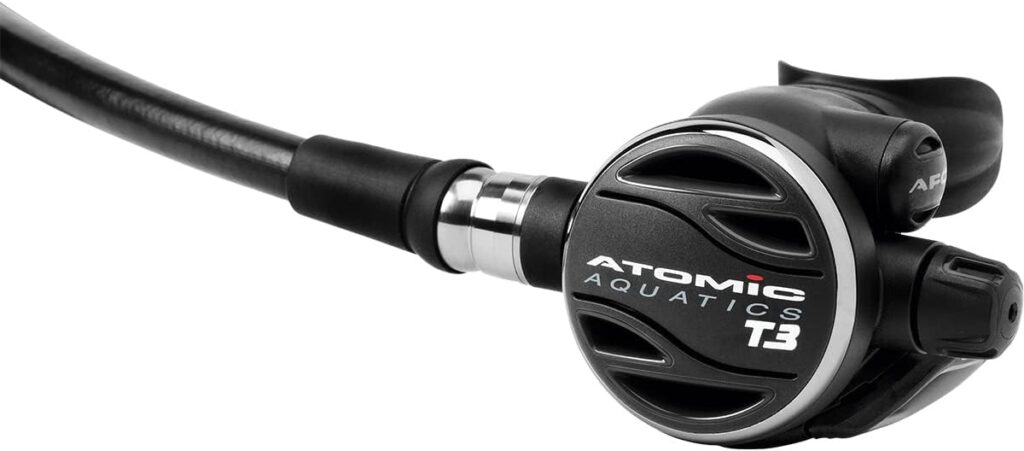
- Price:> $$$
- Balanced Valve
- Airflow Adjustment Dial
- Dual Silicone Mouthpiece
- Super Lightweight (<1.7 lbs)
- First Stage Swivel Torrent & Second Stage Ball Joint
- Titanium Build = Super Durable & Light
In terms of overall quality, the Atomic T3 is the best scuba regulator on the market. It combines insane durability, exceptional lightness and awesome performance.
With a mighty service interval of 3 years, it also has the longest warranty of any model of scuba regulator – but thanks to the titanium build, it’s so durable that it’s highly unlikely to break in the first place.
The mouthpiece is exceptionally comfortable in the wearers mouth; which is partly thanks to the fact that it’s made from not one but two types of super soft silicone.
Further enhancing comfort is the fact that the first stage features a swivel torrent to reduce tugging of the hoses. This, combined with a titanium ball joint in the second stage, means you can freely move your head without feeling like the regulator will be pulled out your mouth. This means you don’t have to bite down so hard on the regulator in the first place, hugely reducing jaw fatigue.
Suited to both warm and cold water diving, the Atomic T3 breathes spectacularly easily, incorporating an advanced valve system and also having the option to easily adjust air delivery via the fluid airflow adjustment dial on the left hand side. Yes, it’s expensive but if you can afford it, the Atomic T3 is one amazing scuba regulator.
PROS:
- Breaths insanely well
- Lightest Regulator
- Super Durable
- Comfortable Mouthpiece (dual-silicone)
- Swivel Torrent & Ball Joint = reduced jaw fatigue
- Works in Tropical & Cold Water
- 3 year service interval
CONS:
- Most expensive scuba regulator!
5) Runner-Up High-End Regulator: Scubapro MK25 A700
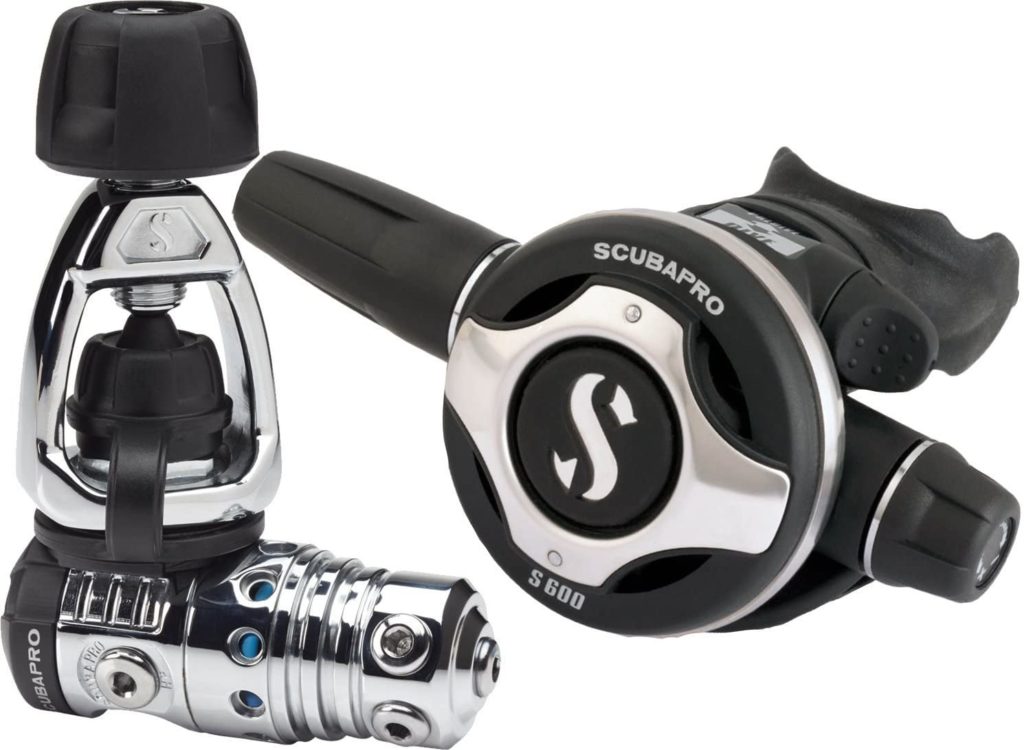
- Price:> $$$
- Air Balanced Valve
- Airflow Adjustment
- Swivel Torrents on First Stage
- Chrome-Plated Brass Body
- Lightweight
- 2 Year Service Warranty
The Scubapro MK25 is another high-end regulator that offers superb durability, performance and comfort; whilst still expensive it is markedly less so than the Atomic T3.
Weighing just 2 pounds, it is one of the lightest scuba regulators on the market and thanks to its chrome plated brass body it is also highly durable.
Its design consists of an air balanced flow-thru-piston mechanism made from balanced stainless steel which allows it to easily deliver more air to the second stage while being unaffected by changes in tank pressure. The result is a regulator that breathes extremely well, something that is frequently cited in user-reviews. There is also an airflow adjustment valve.
The first stage accommodates five ports on a swivelling torrent. A swiveling torrent is a feature only seen in high-end regulators – it allows for 360 degree swivel of hoses meaning the regulator doesn’t tug on your mouth when moving your head. As a result you don’t need to bite down on the mouthpiece so hard, greatly reducing jaw fatigue.
Functioning in both tropical and cold water, this is an awesome alternative to the T3; whilst it can’t boast quite the same level as quality as the T3 it is only half the price and still noticeably better than other regulators on the market.
PROS:
- Second lightest and most durable regulator (after Atomic T3)
- Less expensive than the Atomic T3
- Excellent breathing
- Swivel torrent = less jaw fatigue
- Extremely durable
- Works in cold and warm water
CONS:
- Second most expensive regulator
- No ball joint unlike T3
6) Cheapest Scuba Regulator: Palantic AS103

- Price:> $
- Cheapest Regulator on the Market
- Includes 2 Seconds Stages
- Silicone Mouthpiece
- Chromium-Plated Body
- Over-Balanced First Stage
The cheapest scuba regulator currently on the market is the Palantic AS101: this is a highly popular model and a top selling product on amazon.
In terms of affordability, the Palantic AS101 is significantly cheaper than any other reg; even more so considering that the main price includes two second stages whereas other regs are sold as only one. This is awesome value for money!
Despite how cheap it is, the Palantic AS101 is still a reliable and effective scuba diving regulator: it features environmental sealing, a comfortable silicon mouthpiece and a chromium-plated brass body. The result is a durable regulator that breathes well and is comfortable to use.
Admittedly, it is simpler than more expensive regulators; it lacks an airflow restriction valve, swivel torrent or other features seen on more sophisticated (and expensive) regs. It also does not breathe as smoothly; however it gets the job done and is an excellent choice for any diver looking to buy their first scuba regulator without breaking the bank.
PROS:
- Super Cheap
- Awesome Value for Money: 2 Second Stages
- Easy to Use
- Comfortable Mouthpiece
CONS:
- No Airflow Restriction or other Special Features
- Not Suitable for Cold Water
- Less Durable
- Mouthpiece less comfortable compared to other regs
7) Best Scuba Regulator for Beginners: Scubapro R095
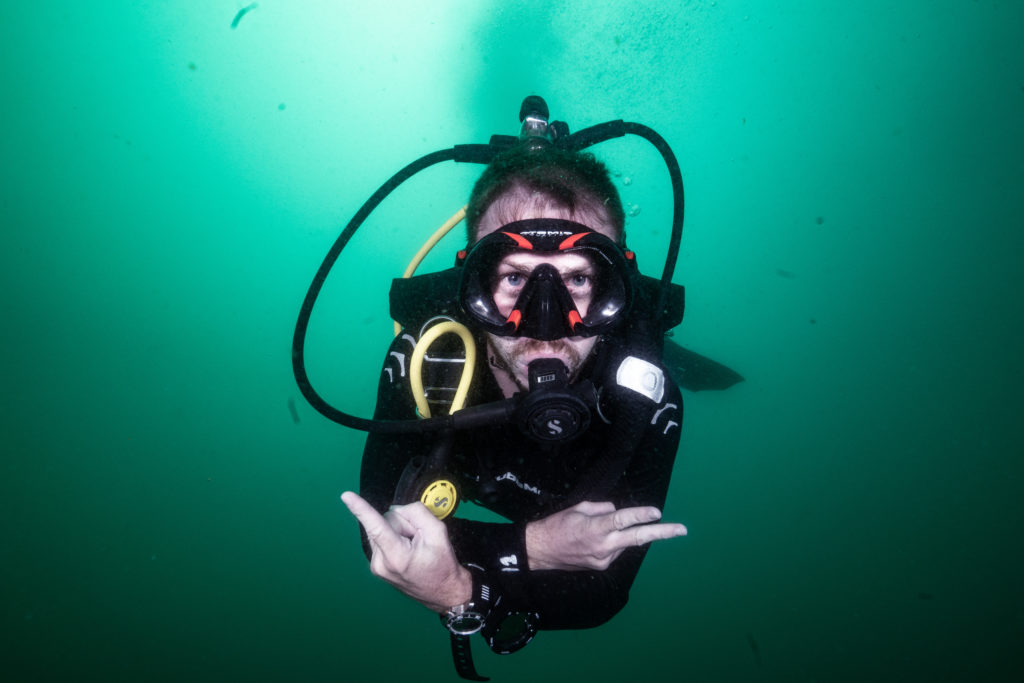
- Price:> $
- Venturi-Initiated Vacuum Assist
- Pre-set to Optimum Inhalation
- Classic Downstream Valve
- Yellow = Highly Visible
- Chrome-Plated Brass Body = Durable
“During my year in Costa Rica, one of my favourite places to dive was Playa del Coco. I always dove with Deep Blue Diving; an awesome dive centre that received an influx of beginners for which they had specially-tailored rental gear including the ScubaPro R095 scuba regulator.
The Scubapro R095 is an extremely reliable and easy to use regulator; one thats been designed especially for newbie divers; having been pre-tuned to the optimum inhalation volume for safe and uncomplicated use.
There’s no airflow adjustment valve but this is actually a good thing because it prevents one from accidentally changing the air delivery from the optimum level it’s already set to. The purge button is bright yellow which makes it highly visible and handy as a backup second stage regulator to share with dive buddies.
The mouthpiece is simple but comfortable and this combined with the reversible hose attachment makes it versatile and flexible to hold in your mouth, reducing jaw fatigue. With classic downstream valve technology it breathes very nicely and it’s also super durable thanks to the all-metal housing. Without a doubt a great regulator for beginners and affordable to”!
Alex: Grand Admiral of the Diving Squad
PROS:
- Cheap
- Extremely Reliable
- Pre-set to Optimum Air Delivery
- No unnecessary extra features
- Durable
- Bright Yellow for High Visibility
CONS:
- Mouthpiece is basic
- Not designed for cold water
- No special features
8) Coloured Purge Button Options: Cressi Compact MC9
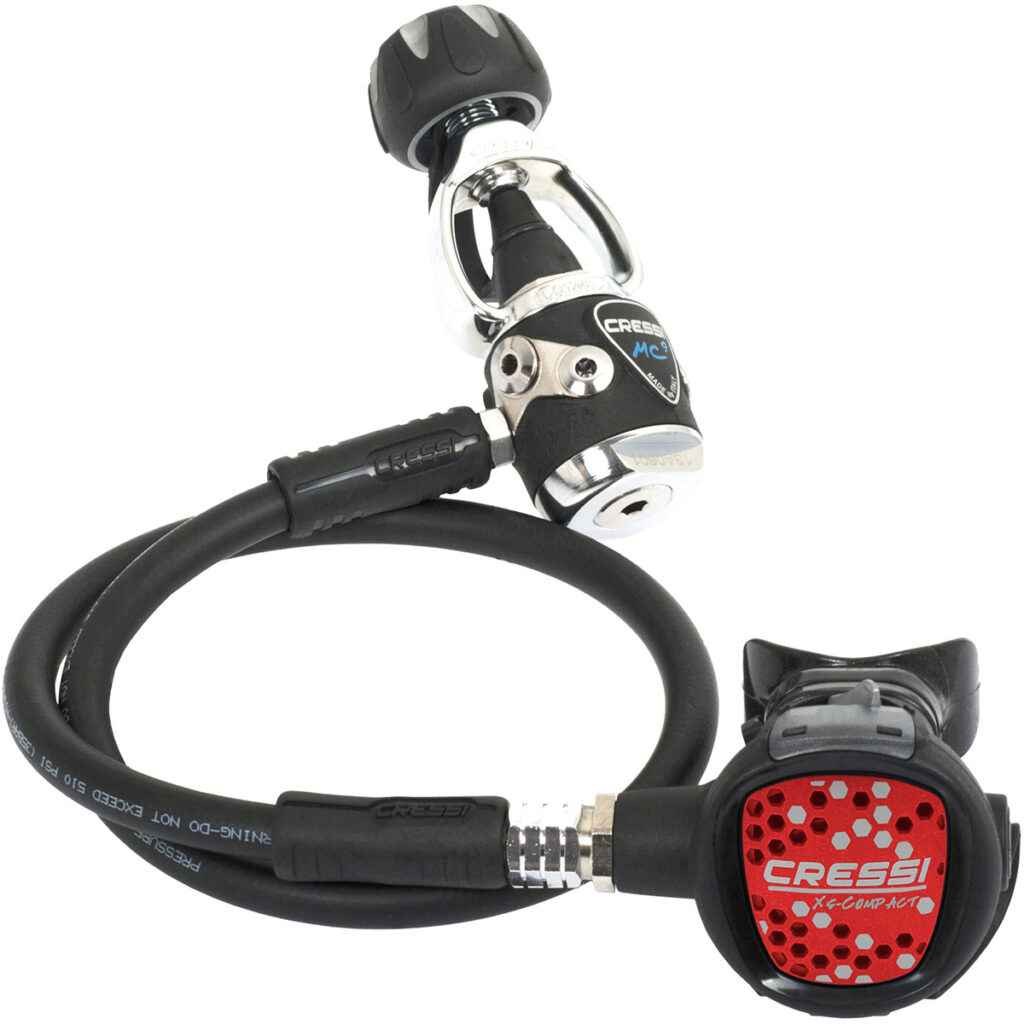
- Price:> $$
- Available with black, red or blue purge button
- T-shape mechanism
- Balanced Diaphragm
- Techno-Polymer second stage
- Anti-Scratch Surface around Purge button
Another super affordable regulator, the Cressi Compact MC9 is compact, durable and stylish; being the only regulator available with a black, red or blue purge button (on scuba.com only), giving it a unique and distinctive appearance.
Regardless of colour, the purge button features a textured anti-scratch surface and a techno-polymer construction for added lightness; making it an ideal travel regulator.
The orthodontic mouthpiece has been specially moulded for improved comfort and is made from extra soft silicone.
Air delivery is surprisingly good considering the price; this is largely due to the fact that the breathing mechanism of the MC9 is arranged on an axis perpendicular to the axis of entry creating a T-shape. Also, the second stage features a flow deviator to modify the Venturi effect as well as a dive / pre-dive adjustment feature.
A superb budget option, the MC9 offers good value for money an a quirky visual appeal.
PROS:
- Affordable
- Breathes really well
- Light
- Durable
- Scratch-proof surface
- Works in cold (and warm) water
CONS:
- No airflow adjustment valve
- Mouthpiece only made from one material
9) Military Regulator of Choice: Mares Abyss 22
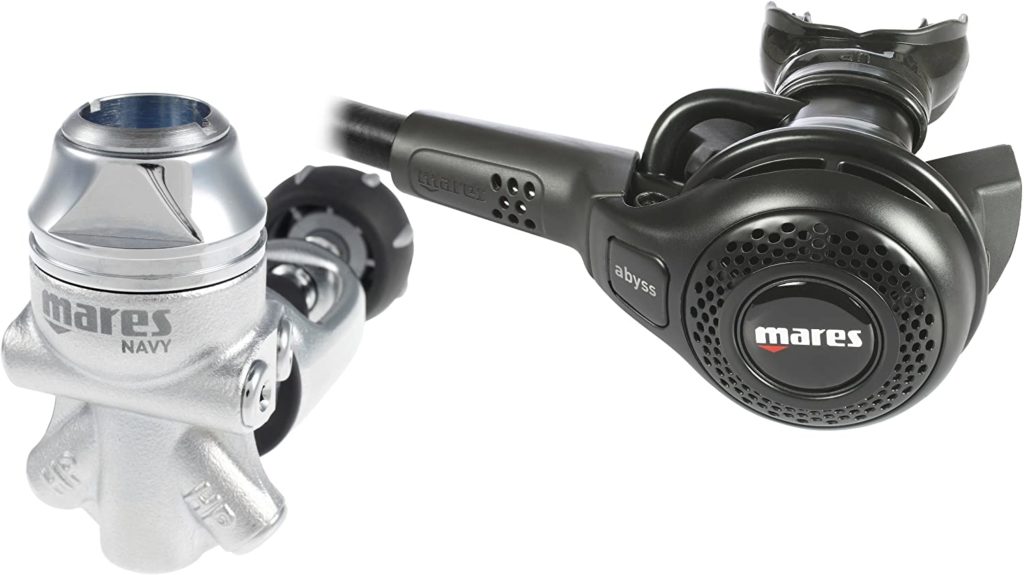
- Price:> $$
- Balanced Diaphragm
- All Metal Construction
- Downstream Demand System
- Vortex Assisted Design
- Mesh Grid
- Dynamic Flow Control
What makes a great scuba diving regulator? If you ask the the US military (ooh-rah!), its the Mares Abyss 22 – the standard issue regulator to US military personnel.
The all-metal construction of this reg not only makes it spectacularly durable; it also gives it supreme thermal properties meaning it works just as well in cold waters as it does in tropical waters.
Air delivery remains excellent and unchanging at all depths thanks to the vortex assisted design combined with fact that the second stage implements a singular downstream demand system valve. Because of this, there’s no need to over-complicated this regulator with an airflow valve. The entire ethos behind the Mares Abyss 22 is less is more!
The first stage features the Mares patented “Dynamic Flow Control” mechanism which reduces dips in intermediate pressure when you inhale. This is extremely useful in challenging diving conditions such as when you may be exerting yourself whilst swimming against a strong current or infiltrating a terrorist-seized nuclear submarine.
PROS:
- Constant airflow without user-adjustment
- Performs great even in the most challenging dive conditions
- Comfortable mouthpiece
- Light
- Highly Durable
CONS:
- No Airflow Adjustment Valve
- Pretty Expensive
10) Most Durable Budget Scuba Regulator: Sherwood Scuba Brut Pro

- Price:> $$
- Marine – Grade Brass Construction = Super Durable
- Pneumatically Balanced Design
- Mouthpiece made from 2 Silicone Compounds
- Large Diaphgram and Exhaust Valve
Used by public safety divers around the world, the Sherwood Brut Pro is a highly durable and rugged scuba regulator that can handle a heavy beating, being constructed from marine-grade brass.
It features a patented dry seal internal system to keep the inside free of contaminants. This means that intermediate pressure can be increased without the use of grease meaning this reg is practically immune to salt, sand and chlorine.
It may be a little bulky and heavier than other scuba regulators but many consider the Sherwood Brut Pro to be one of the toughest regulators of all time and certainly the most tough among regulators within it’s price bracket (which leans towards the low-end of mid-priced).
Considering the low price point, air delivery is very good – this is because the Brut second stage incorporates a large diaphragm and exhaust valve to ensure optimal inhalation response and reduced exhalation resistance. The mouthpiece is made from two silicone compounds (unusual in budget regulators) for added comfort.
This is a budget friendly and highly durable scuba regulator – it may not have the fancy features of more high-end regulators but for the price it’s at, it offers awesome value for money.
PROS:
- Super Durable – Externally and Internally
- 2 Silicone Types in Mouthpiece
- Affordable
- Breathes well
CONS:
- Bulkier and Heavier than other regs
- No Airflow Adjustment
- No Other Special Features
FAQ & INFO
(Click here to ascend back up to the quick look section and reviews).
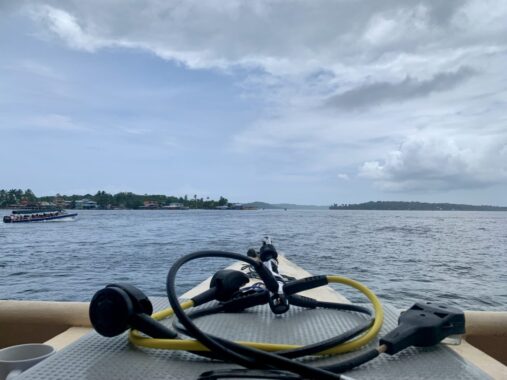
What’s the difference between a first stage and a second stage?
- First Stage: The first stage of the regulator is the part that you screw directly onto the air cylinder tank. It reduces the high air pressure in the cylinder to an intermediate pressure that can be utilised by the second stage. You only need one first stage per regulator setup – aka scuba octopus setup.
- Second Stage: The second stage attaches to the first stage via a low pressure hose and is the part of the regulator that goes in your mouth so you can breathe through it. In a complete regulator setup, you have two second stages: your primary second stage which you mainly use and your alternate second stage for in case you need to lend a buddy air.
FIRST STAGE:
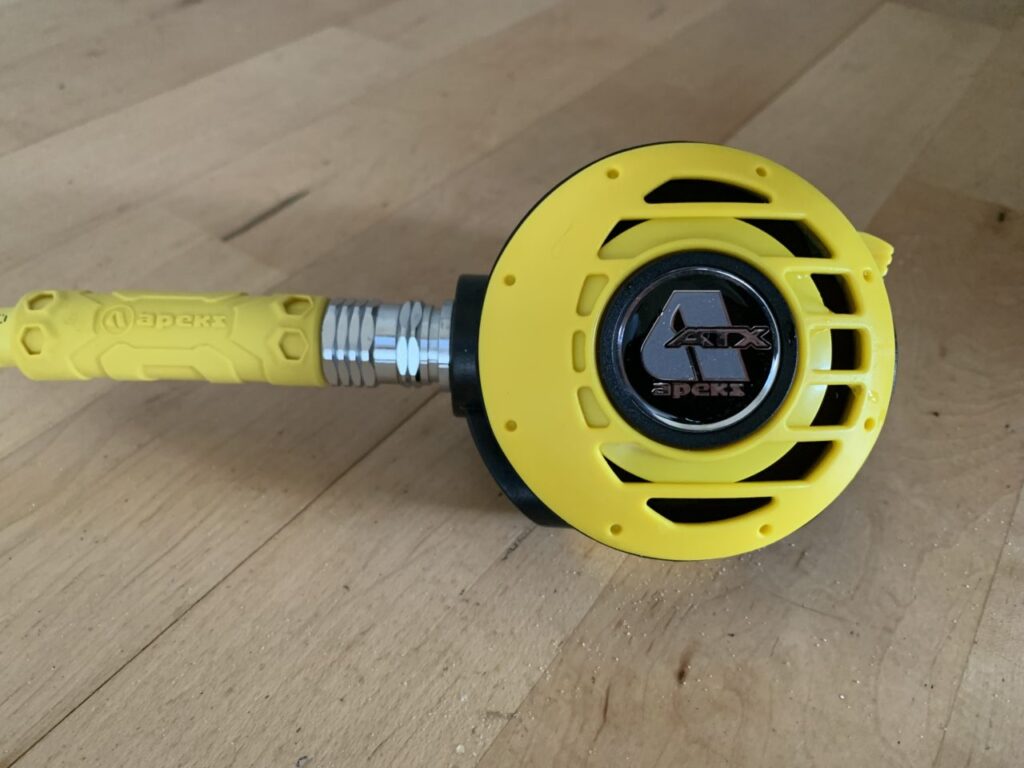
SECOND STAGE:
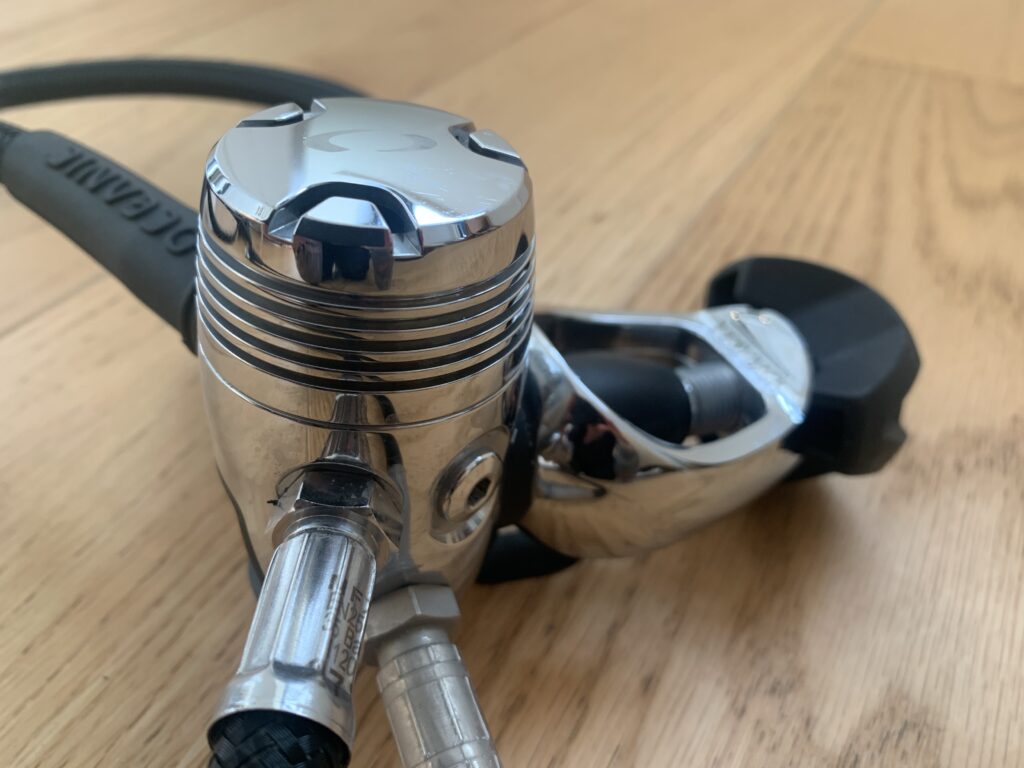
Should I buy a first stage and second stage together?
If you don’t have any regulator equipment, to build a complete, functioning regulator setup, yes – you’ll need to get the second stage and first stage together. However, for a complete octopus setup, you only need one first stage but you need two second stages – a primary and an alternate second stage.
Often, scuba divers buy a fancier second stage for their primary second stage and a cheaper option for their alternate second stage as it rarely gets used.
I strongly recommend that when buying your primary second stage, you choose a matching first stage to go with it – that is one from the same scuba diving manufacturer e.g. aqualung for aqualung, mares for mares, apeks for apeks.
Most scuba regulator packages for sale include one FIRST stage and one second stage, although a few include both second stages – it varies by the model and manufacturer.
So assuming you buy a package on amazon that includes the first stage and second stage, when you are buying your alternate second stage, make sure you don’t buy it with the first stage – as this will cost significantly more but you don’t need two first stages for a complete octopus setup.
The other thing you will need however, is a pressure gauge but these are hardly ever included in scuba regulator setups which doesn’t matter as they’re fairly cheap anyway.
So when buying your regulator setup, the main parts, which is what we’ve focused on in this article are the first stage and the
COMPLETE REGULATOR SETUP: 1 first stage, 2 second stages, pressure gauge and bcd inflator hose.

DIN or Yoke?
Ah the age old question about scuba divers – DIN or Yoke? Let’s backtrack a mo’. What even is DIN or Yoke?!
Most models of regulator first stage are available in either DIN form or Yoke form.
On a Yoke first stage (aka a clamp-style), the o-ring is exposed to the cylinder valve. It has an opening which connects to the exposed o-ring and a pin which screw into the back of the cylinder valve; thus holding it in place.
On a DIN first stage there is a threaded opening which screws directly into the cylinder valve.
Nowadays, a lot of divers prefer DIN first stages because they’re slightly lighter than Yoke first stages, less likely to leak and also they don’t stick up from the back of the tank meaning they’re unlikely to bang into something directly above you (if for example you’re under the roof of a tunnel or cave or in a tight shipwreck) which can happen with Yokes.
A few divers still prefer Yokes; this is generally due to a sense of familiarity as in some parts of the world Yoke first stages are more commonly found in dive centres than DINs. However, DIN’s the future and it’s likely that the older Yoke will eventually become obsolete even if not for a while.
Generally we recommend buying a first stage that is DIN and for this reason we’ve included links to buy the DIN versions on amazon. However, most models of first stage are available on amazon in Yoke if you so choose!
Do I need a regulator that works in cold water?
These days, a lot of mid-priced and luxury scuba regulators are able to perform in cold water – although generally speaking, the super cheap models can’t.
When we say cold water; we’re talking about diving in water that is below 60 degrees Farenheit / 15 Celcius. At the warmest end of this range you’ll be wearing a very thick wetsuit – think 7mm and when it get’s colder you’ll be in a drysuit.
The vast majority of recreational scuba diving takes place in waters that are significantly warmer than this. If you’re diving somewhere with palm trees, lots of sand or anything else tropical – that’s in warm water.
So most divers won’t need a cold water regulator – and if you are a cold water diver, you probably already know your sport very well so you’re probably well aware of the special gear you need for diving cold water.
However, many mid-priced and all luxury scuba regulators can perform in cold water – in many ways this is a metric of their quality and the sophistication of their internal mechanisms.
So whilst it’s likely that most people won’t need a cold water regulator, if you buy a good quality regulator for tropical water diving, chances are high that it can also work in cold water.
What is environmental sealing?
Some regulator first stages have an alcohol or silicone based fluid which seals a watertight barrier inside the first stage. This is known as environmental sealing. It prevents icing on the first stage which is necessary for cold water diving.
What does it mean if a regulator is balanced or unbalanced?
An unbalanced regulator uses a piston and diaphragm design and produce an increase in breathing resistance as a diver descends deeper or tank pressure drops (due to air being used up).
Balanced regulators are superior because they compensate for increasing depth and decreasing tank pressure by equalising air pressure on both sides of the valve. This allows you to breathe more easily.
Nowadays the majority of scuba regulators are balanced with only some of the very cheap optins being unbalanced.
Why do some regulators breathe more easily?
Whilst balanced regulators breathe more easily than unbalanced regulators, there are more factors than just the presences or absence of this feature that determine how easily a regulator breathes – mostly regarding it’s internal working mechanisms and also how well it is tuned and adjusted.
The breathing ability of a regulator is a strong measure of its overall worth – generally speaking the more expensive, high quality regulators will breath more easily with the most expensive options being the best breathers.
What is an orthodontic mouthpiece?
The mouthpiece refers to the part of the regulator that actually goes in your mouth – it’s often got those little tabs that you bite down on.
When a mouthpiece is said to be orthodontic that just means it’s been designed with the very latest knowledge in orthodontics to make it as comfortable as possible and avoid you getting a mouth.
Pretty much all modern scuba regulators have an orthodontic mouthpiece.
What’s actually more relevant is whether that mouthpiece is made from one material – or if features a dual material construction.
Dual material mouthpieces are more comfortable and softer to have in your mouth so you avoid getting a tired or stiff jaw which may otherwise happen when you’ve been diving a lot.
Most higher quality scuba regulator feature dual-material mouthpieces.
Scuba regulator mouthpieces are usually but not always made from silicone.
Most are designed to fit all mouth sizes and shapes but some, such as that of the Aqualung Mikron are designed for smaller mouths.
It can be extra comfortable to wear a mouthpiece if it’s attached to a first stage that features swivel points on it’s attachment ports as it stops the regulator hose straining against your mouth when you move your head.
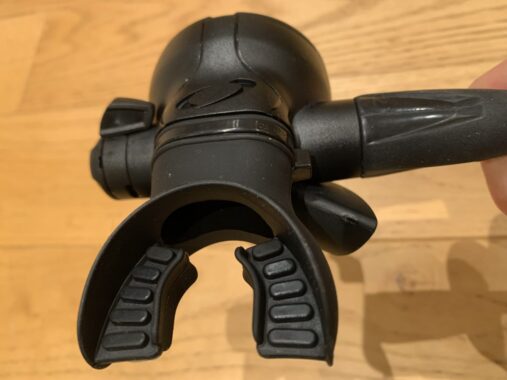
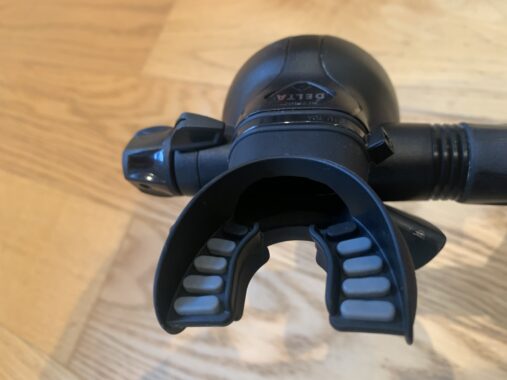
How often do I need to get my regulator serviced?
Never forget – ya gotta get your scuba regulator serviced to to make sure it is still operating to full capacity. Considering that it’s the most important part of your underwater life support system – that which allows you to breathe air, this is super important!
You can take your scuba regulator to get serviced at your local dive shop or centre.
The Atomic T3 – the most expensive scuba regulator going, is unique in that it’s so durable it only needs to be serviced once every three years! However with most models of scuba regulator they must be serviced every one or two years. Be sure to find out how long the service interval is for the specific model of regulator that you buy.
What makes a good travel regulator?
You can travel with any scuba regulator, but those which are extra light and compact are that little bit easier to take globe trotting with you. The lightest scuba regulators on the market are the Atomic T3 and the Aqualung Mikron. Both are also super compact.
What should I consider when buying a scuba regulator?
The number one thing you’ll want to consider is your budget. For example the most expensive scuba regulator costs many times the price of the cheapest regulator. There’s also some really great mid-priced options that offer an awesome balance of quality and affordability.
If you’re planning to dive in cold water, you’ll obviously want to make sure you’ve got a scuba regulator that’s capable of doing that. And if you plan to travel a lot, you may find a lighter, more compact regulator a convenient buy.
Generally speaking with scuba regulators, you get what you pay for – the more you spend, the better it is – i.e. more durable, breathes better, more comfortable mouthpiece, more special features, lighter and so on. But you can rest assured that even the cheapest models of scuba diving regulator we’ve reviewed on this page are both safe and reliable.
Diving Squad Debriefing
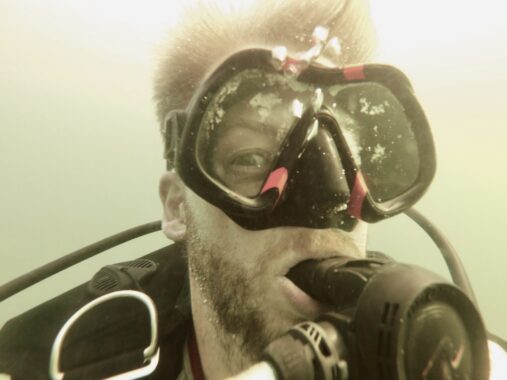
Alrighty, Diving Squad! You’ve made it all the way down to the sea-floor of this article – there’s no more to go!
We’ve covered the best scuba regulators across a wide budget range from the very cheapest models available all the way up to the most cutting-edge luxury models and with everything in between.
We constantly review and update our content, so you can rest assured that what you’ve read today reflects the very latest news and info regarding scuba diving regulators in 2024.
Hopefully you’ve found this article useful, maybe even learned something you didn’t know and you’re now ready to go forth and craft your ultimate scuba regulator set up!
Good luck and peace out!!
Support the Squad!
We are part of the Amazon Services LLC Associate Program. If you make a purchase on amazon after clicking a link on Diving Squad, we earn a small commission fee, at no extra cost to yourself.
We are also part of several other affiliate programs so if you click on a Diving Squad affiliate link that results in you booking a liveaboard, booking accommodation, purchasing insurance or buying a product somewhere else, once more we make a small commission, without it costing you a cent extra. Thanks!
